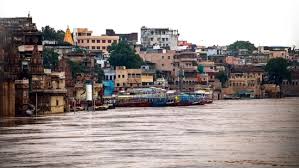Flood alert in Varanasi as Ganga in spate, ghats submerged

Varanasi, July 17 — The city of Varanasi is on high alert as the Ganga river continues to rise rapidly. Due to continuous heavy rainfall across the region and upstream areas, the river has overflowed, submerging all 84 of its historic ghats. As a result, life along the riverfront has come to a standstill.
Ghats Go Underwater, Rituals Disrupted
The Ganga reached a level of 68.9 meters on Wednesday evening, approaching the warning mark of 70.26 meters. Although the river hasn’t crossed the danger level yet, it is rising at 1 centimeter per hour. Consequently, several ghats—including Dashashwamedh, Assi, and Manikarnika—are now underwater.
Because of this, daily religious rituals like bathing, cremation, and the famous Ganga Aarti have shifted. Priests now perform the evening prayer from raised platforms, while authorities have suspended boat services to ensure public safety.
Authorities Act Swiftly
To manage the situation, the district administration has deployed 46 flood control outposts in low-lying areas. Moreover, teams from the National Disaster Response Force (NDRF), State Disaster Response Force (SDRF), and Provincial Armed Constabulary (PAC) are monitoring the area closely.
District Magistrate S. Rajalingam urged residents to remain cautious. He said, “We’re watching the water levels closely. Relief camps are operational, and our teams are ready for any emergency.” As a precaution, officials have identified vulnerable neighborhoods like Nagwa, Rajghat, and Bhadaini for possible evacuation.
Neighboring Regions Also Affected
In addition to Varanasi, neighboring districts such as Ballia, Ghazipur, and Mirzapur are experiencing rising water levels. For example, in Prayagraj, water has entered the Bade Hanuman Temple and flooded nearby streets.
According to flood monitoring officer Ramesh Yadav, continued rainfall in Uttarakhand and eastern Uttar Pradesh could worsen the situation. “If the rain doesn’t stop upstream, we may see the Ganga cross the danger mark within 48 hours,” he explained.
Impact on Tourism and Livelihoods
Tourism in Varanasi has taken a hit. With the ghats underwater, pilgrims can no longer take holy dips or attend the aarti from the riverbanks. As a result, local businesses, tour guides, and boatmen are struggling.
“I waited years to visit Varanasi and see the aarti. Now, I can’t even reach the ghat,” said Anita Sharma, a tourist from Mumbai. Local priest Vishwanath Mishra added, “We depend on the ghats for our rituals and income. Everything has stopped.”
Health Risks and Sanitation Measures
Alongside the flood threat, sanitation issues are emerging. Floodwater has mixed with garbage and sewage in some areas, raising concerns about disease outbreaks. In response, the Municipal Corporation is using chlorine to treat stagnant water. Additionally, health camps are being set up in areas like Bhelupur and Godowlia.
Doctors are advising people to drink boiled water, wear protective footwear, and report symptoms like fever or rashes immediately.
Public Advised to Stay Alert
Officials have issued several safety guidelines:
- Avoid visiting flooded ghats or riverbanks.
- Do not use contaminated water.
- Follow instructions from local authorities without delay.
- Stay updated via local news or official announcements.
The India Meteorological Department (IMD) has predicted continued rainfall for the next few days. Therefore, residents should remain vigilant and prepare for worsening conditions.
Faith and Resilience Keep the City Going
Despite the difficulties, the people of Varanasi continue to display strength and faith. Social media is full of images showing submerged temples and flooded ghats, yet many express spiritual awe instead of fear.
“This river is our mother. She gives and she takes. We believe she’ll calm soon,” said Sushil Pandey, a flower seller at Assi Ghat.
Conclusion
The flood situation in Varanasi is evolving quickly. While the Ganga hasn’t crossed the danger mark yet, its steady rise calls for caution. Thanks to quick administrative response and the community’s resilience, the city is handling the crisis effectively. However, with more rain in the forecast, preparedness remains crucial.






